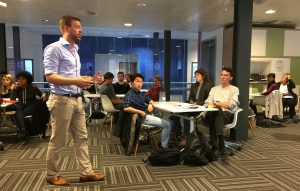Even in a seemingly homogeneous group of students, many differences between students exist. In an inclusive classroom, visible and invisible differences, for instance in class, religion, ethnicity, gender, culture, sexuality or (dis)ability, are not seen as a disadvantage, but are used as a means to increase awareness and to show more perspectives on academic and societal matters.
This may also be used to exemplify that there is not always one correct answer. In an inclusive classroom, this awareness of differences is reflected in the learning goals, the course content and the teaching, learning and assessment methods[1].
[1] If the course content is more straightforward or if it is not possible to discuss about it from multiple perspectives, another crucial aspect of inclusive education is to be aware of the implicit assumptions and expectations about teaching and learning. Lecturers and students both have expectations about their role in and out of class, how to work together, what needs to be learned and how it will be assessed. Assumptions are made about what students know and are able to do. When such expectations are not made explicit and assumptions are not checked, this can lead to confusion or unexpected or unwanted behaviour and disappointing results.
Getting started
Preparation
- Be(come) aware of your own (cultural) expectations and assumptions about teaching and learning, for instance, by discussing these with international colleagues or colleagues from different departments.
- Consider the literature that you are using for the course: is there a (or some) diversity in the perspectives and origin of the literature?
- Consider the examples you use in your teaching: are they based on information students should all be able to know about? If you use very specific or local examples, your students may not be able to understand you. In some cases, what a lecturer presents as a problem, may not be perceived as being a problem for students with a different cultural background.
- Find out who your students are and what they expect from the course prior to the course, by using a simple online questionnaire (e.g. in Brightspace).
- Discuss with colleagues how your course relates to their courses, so you can relate your course to the prior knowledge and skills of your students.
In class
- Greet your students when they enter your classroom for the first time, it is a very simple way of showing you are interested.
- During your first meeting with the students reserve some time to ask the students to share with you and/or each other a bit about their educational experience. Have they written essays before (and what do they mean by essay)? Have they worked in groups before or have they given feedback to each other?
- Reserve some time in the first meeting to explain what you expect of the students, how they should, for example, collaborate and especially why you choose certain learning activities. It is not common for all students to share their thoughts, give feedback or work together. Therefore explaining why you find this important may help to increase student understanding.
- When students have to work in groups and you want to mix them based on their cultural diversity, be sure that the mix is relevant for the assignment they are working on. It helps if the assignment asks for different perspectives or experiences that your students may be able to bring forward.
- Ask students about their experiences and examples pertaining to the course content; this may lead to interesting and unexpected discussions, but also enables you to check your assumptions about expected prior knowledge and skills.
- Tell students that if they have specific needs in order to learn well, they can mention this to you (privately) and that you will do your best to help them.
- In big lecture halls, walk around the room and also go to the back of the room. Use a microphone and inform your students you will walk around (managing expectations!). In this way you can also connect with the students in the back.

 Our globalised world necessitates fostering graduates’ and teachers’ international and intercultural competence; the ability to situate knowledge in an international context and show awareness of the culture-specific and social nature of knowledge and values, including their own. For students, such competences are of crucial importance for employability and their roles as global citizens in an increasingly diverse society. To that end, universities seek to offer students an international experience at home and abroad, and also stresses the importance of providing students with international perspectives, by including the comparative analysis of global issues in curricula. As a result, classrooms become increasingly diverse, giving rise to plenty of opportunities and challenges for teachers and students.
Our globalised world necessitates fostering graduates’ and teachers’ international and intercultural competence; the ability to situate knowledge in an international context and show awareness of the culture-specific and social nature of knowledge and values, including their own. For students, such competences are of crucial importance for employability and their roles as global citizens in an increasingly diverse society. To that end, universities seek to offer students an international experience at home and abroad, and also stresses the importance of providing students with international perspectives, by including the comparative analysis of global issues in curricula. As a result, classrooms become increasingly diverse, giving rise to plenty of opportunities and challenges for teachers and students.